|
|
 |
 |
 |
 |
 |
|
|
|
 |
|
 |
|
 |
|
At picnics and parties in the East Bay, Max and friends explore new musical worlds with African drums, Appalachian banjo, saxophone, flute, and vocal improv.
After the destruction of Max’s San Francisco loft and the loss of the Terra Incognita band’s studio in the Loma Prieta earthquake of 1989, Max moved across the Bay to Oakland. Terra Incognita drummer Michael Corbett helped him to acquire and learn African drums and percussion, and eventually they started a new band, Wickiup, based on tribal-inspired rhythms. Mike habitually gives everyone and everything a parody of their name, hence “Wicki Schmuck.” This volume combines the best moments from jam sessions featuring Max and his Bay Area friends from 1990 to 1995, when Wickiup disbanded and Max moved to Los Angeles. Most of them took place at picnics or parties, resulting in erratic sound quality.
We hope your ears are tickled by the distinctive buzz of the West African gungon drum, caused by a gut snare rattling against the drum’s goatskin head!
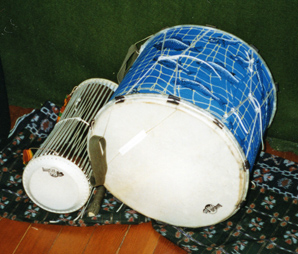
Release date May 25, 2018
Copyright © 2018 Max Carmichael
|
|
|
|
 |
|
Sessions & Tracks: |
|
 |
|
Drummage American Style
Tilden Park, East Bay Hills, August, 1990: Max, Michael Corbett, Katie Rauh, Kenny Schachat, Bruce Bjerke, Kele Duncan, Quinn Walker, John Walker

01 Possession
Gungon: Kenny; Talking Drums: Mike & Max; Percussion: Katie, Kele, John
02 Big Drum Stomp
Gungon: Mike; Talking Drum: Max; Conga: Katie; Percussion: Kele, John
03 Mystery Spot
Sax: Bruce; Talking Drums: Mike & Kenny; Gungon: Max; Percussion: Katie, Kele, John
04 Kenny’s Kalimba
|
|
 |
|
Drums of Love
Tilden Park, East Bay Hills, October 13, 1991: Max, Michael Corbett, Millie (Mila) Morales, Kerry Gaffey
05 Tom Tom Klub
Gungon: Max; Talking Drum: Mike; Shekere: Millie
06 Rolling Thunder
Gungon: Max, Talking Drum: Mike
|
|
 |
|
How Swarming Party
Max’s Oaktown Ranch, January 26, 1992: Max, Michael Corbett, Bruce Bjerke, Kat Keigharn, Josiah Seiver, Millie (Mila) Morales, Carson Barnes, John Walker, Quinn Walker, and others. Max’s ranch, in the Temescal District of Oakland, was built on the site of a Native American sweat lodge which gave the neighborhood its name.
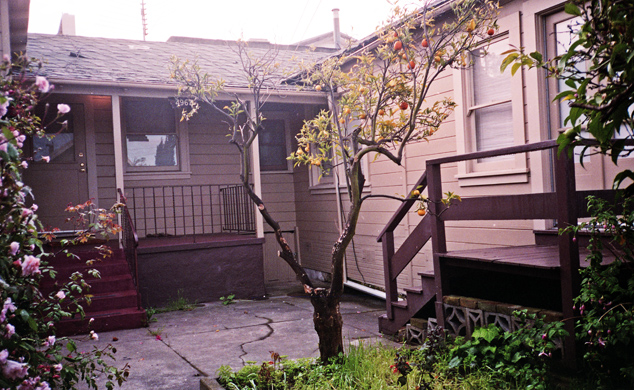
07 Kountry Karavan
Banjo: Max; Talking Drum: Mike; Sax: Bruce; Percussion: Kat, Millie, John, Josiah
08 Train 45
Banjo & Vocal: Max; Sax: Bruce; Congas: Mike; Percussion: Kat, Millie, John, Josiah
09 Off Broadway
Shekere: Max; Talking Drum: Mike; Sax: Bruce
10 Last Stop Jupitah
Sax: Bruce; Talking Drums: Max & Mike; Percussion: Kat, Millie, John, Josiah
|
|
 |
|
Wickiup Jam
37th Street Studio, Oakland, January 22, 1994: Max, Jane De Cuir, Michael Corbett
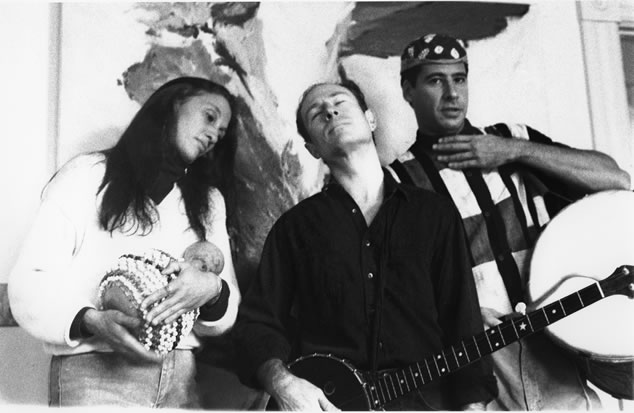
11 I Remember I K Dairo
Gungon: Mike; Guitar & Talking Drum: Max; Shekere: Jane
12 Shining Eyes
Guitar & Vocal: Max; Talking Drum: Mike; Shekere & Vocal: Jane
13 Lone Riders
Guitar: Max; Talking Drum: Mike; Cowbell: Jane
14 Jackalope’s Lament
Gungon: Mike; Guitar: Max; Cowbell: Jane
|
|
 |
|
Wickiup Barbecue
Tilden Park, East Bay Hills, April 16, 1994: Max, Michael Corbett, Bruce Bjerke, Kat Keigharn, Josiah Seiver, Carson Barnes, Quinn Walker, John Walker, and others
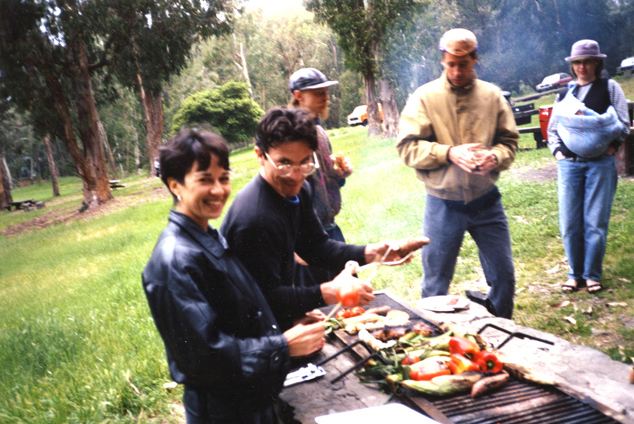
15 Centipede Waltz
Gungon: Mike; Banjo: Max; Percussion: Kat, Bruce, John
16 Hai Yucka Hai-Ya Na Hai-Yuh
Vocal: Josiah; Gungon: Mike; Banjo: Max; Percussion: Kat, Bruce
17 Bouncin’ Bones
Wooden tongue drum, misc. percussion: Various
18 Knick Knack Knook
Gungon: Mike; Talking Drum: Max; Vocals & Percussion: Various
19 Wicki Schmuck Society
Gungon: Mike; Talking Drum: Max; Percussion: Various
|
|
 |
|
Wickiup Jam
37th Street Studio, Oakland, October, 1994: Mike & Max
20 Welcome to Nowhere
Vocals: Mike & Max
|
|
 |
|
Historic Sessions: Buried Treasure from the Archives |
|
 |
|
In the old cliche, new music is created by an individual composer or songwriter sitting alone with a keyboard or guitar. That's great for creating formulaic hits in an established genre, but it may not help the artist to learn new things, expand his or her horizons, or achieve breakthroughs. Music is primarily a social activity, and it thrives when the communal memory and imagination of a group flows together in the space between players, and even audience members, to create those magic, irreproducible moments that become the highlights of our musical experience.
Knowing this, Max and his musician friends have always tried to record their jam sessions and parties with whatever technology was available, and dub the best tracks onto compilation tapes that they'd give titles – evoking the memory of the event itself – and share with each other.
If they were camping out in the desert, they'd use a cheap battery-powered boom box with cassette tapes. In the early years of the Terra Incognita loft, they borrowed a friend's old reel-to-reel deck with 7" tapes, recording at low speed so they could play for 90 minutes at a time without changing reels. And when Sony launched its Pro series of compact, portable, high-quality cassette recorders, they adopted the rugged metal-bodied D6C, with its little stereo microphone, as the standard. Cassette tapes were perfect for sharing – a physical object, not too big and not too small, that they could decorate with handmade art. These compilation tapes were not the better-known "mixtapes" of commercial music, but collections of the musicians' own best work, to inspire them to keep going.
After decades of balancing the conflicting egos of musicians in a long series of groups and struggling to survive as an artist in California's increasingly hostile economy, Max finally lost heart and decided to work alone. But recently, digging into his archives – two boxes containing hundreds of cassette tapes – he found buried treasure: dozens of hours of jam sessions he'd recorded but never had the chance to listen to afterwards. And he began to think of ways to distill these lost gems into the ultimate compilations of spontaneous music to share with his friends and fans.
When you're truly improvising, you're going to make mistakes. And what seems to be a mistake at first, sometimes turns out to be a discovery. But professional musicians are trained to avoid mistakes, so they often lack the freedom or courage to improvise. Even in jazz, which is most people's only experience of improvised music, the players are following an established song structure and are only allowed brief solos in which to embellish on the composer's themes in familiar ways. In free improvisation, without an established structure, the mistakes are part of the discovery process.
Non-musicians may sometimes find these raw, improvised tracks hard to listen to, but musicians know that we learn the most from work that challenges us. |
|
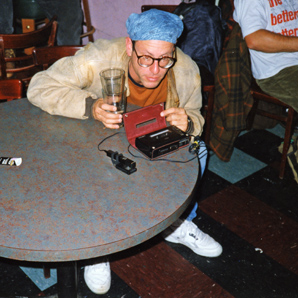
Friend Josiah with Sony Pro cassette recorder, recording Wickiup at San Francisco's Bottom of the Hill nightclub
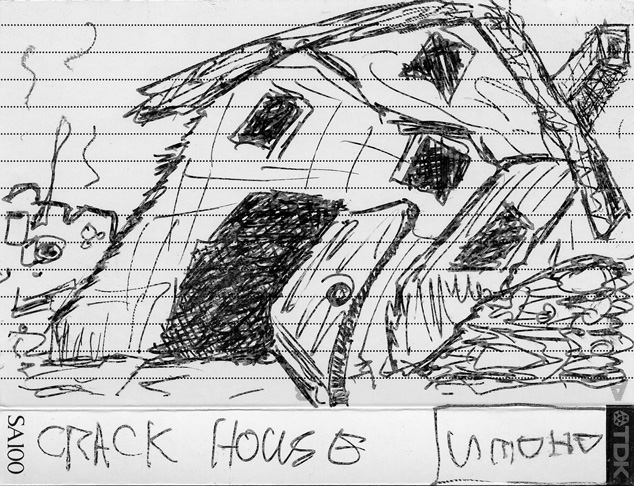
Mark Norris's compilation tape from the Didactyl Brothers' "Crack House" jam session |
|
|
 |
 |
|